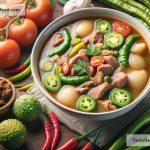Title: Why Filipino Sinigang is the Ultimate Sour Soup
There’s a wealth of incredible soups from around the globe, each with its unique blend of ingredients and flavors, warming hearts and bellies. While many cultures have their take on sour soups, the Filipino dish Sinigang stands out as the ultimate sour soup. This beloved dish is not just food; it’s a hug in a bowl, a taste of home for Filipinos everywhere. Let’s dive into why Sinigang holds such a special place in the hearts of many and why it merits the title of the ultimate sour soup.
A Symphony of Flavors
Sinigang’s magic lies in its delicately balanced symphony of flavors. The soup is primarily sour, but not overpoweringly so. Its tanginess comes from natural ingredients like tamarind, green mangoes, or calamansi—a type of Philippine lime. This sourness is beautifully balanced with the inherent flavors of whatever main ingredient is used, be it pork, beef, fish, or shrimp, creating a harmony of tastes that dance on the palate. Vegetables such as water spinach, radish, eggplant, and string beans add a fresh, earthy component, making the dish both complex and comforting.
Health in a Bowl
Sinigang is not just delicious; it’s also packed with nutrients. The variety of vegetables in the soup make it a fiber-rich meal, aiding digestion. The tamarind base provides a healthy dose of vitamin C, important for immune system boosting, and the various meats or seafood options contribute protein, making it a well-rounded dish. Eating a bowl of Sinigang can nourish the body and soul, making it a comforting choice for both rainy days and moments when a bit of TLC is needed.
Cultural Heritage and Versatility
Part of what makes Sinigang so special is its deep roots in Filipino culture. It’s a dish that tells a story of tradition, of families gathered around the table, sharing stories and enjoying a meal prepared with love. The versatility of Sinigang speaks to the creativity and adaptability of Filipino cuisine. Each region, and indeed each household, may have its version, using ingredients that are locally available or preferred by the family. This adaptability means that Sinigang is both a personal and shared experience, a hallmark of Filipino culinary tradition.
Community and Comfort
Beyond its delicious taste, Sinigang is a dish that embodies the Filipino values of community and sharing. It’s a meal that brings people together, often cooked in large pots to feed a family or a gathering of friends. The act of sharing Sinigang, of passing around bowls of this warm, sour soup, creates a sense of community and belonging. It’s comfort food in the truest sense of the word, providing not just physical warmth but emotional warmth as well.
Unmatched Sourness
What truly sets Sinigang apart as the ultimate sour soup is the unmatched depth of its sour flavor. Unlike other sour soups that may rely on a single ingredient for their tanginess, Sinigang’s use of various souring agents lends it a unique, complex sour profile that is hard to find elsewhere. The sourness is invigorating, waking up the taste buds and stimulating the appetite, making it a perfect starter or main dish.
Global Appeal
While Sinigang is a distinctly Filipino dish, its appeal transcends borders. Its combination of sourness, richness, and freshness can cater to a global palette, inviting food lovers from around the world to explore Filipino cuisine. Chefs and home cooks alike have begun experimenting with Sinigang, introducing it to new audiences and sometimes even giving it their twist, further solidifying its status as a versatile and universally loved dish.
In conclusion, Filipino Sinigang is the ultimate sour soup for a myriad of reasons. It’s not just about the perfectly balanced sour taste or the nutritional benefits. Sinigang represents a piece of Filipino culture, a testament to the country’s rich culinary traditions and the warm, welcoming spirit of its people. Whether you’re seeking comfort, nostalgia, or simply a delicious, heartwarming meal, Sinigang is a dish that delivers on all fronts. Its unique blend of flavors, health benefits, and cultural significance make it a standout in the world of sour soups and a beloved favorite for anyone who tries it.


